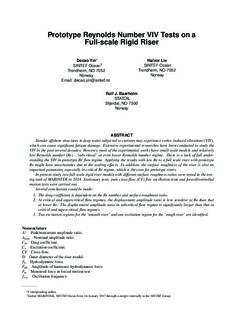| dc.contributor.author | Yin, Decao | |
| dc.contributor.author | Lie, Halvor | |
| dc.contributor.author | Baarholm, Rolf Jarle | |
| dc.date.accessioned | 2017-09-30T16:45:27Z | |
| dc.date.available | 2017-09-30T16:45:27Z | |
| dc.date.created | 2017-08-22T19:00:12Z | |
| dc.date.issued | 2017-09 | |
| dc.identifier.citation | Journal of Offshore Mechanics and Arctic Engineering | Volume 140 | Issue 1 | research-article | nb_NO |
| dc.identifier.issn | 0892-7219 | |
| dc.identifier.uri | http://hdl.handle.net/11250/2457587 | |
| dc.description.abstract | Slender offshore structures in deep water subjected to currents may experience vortex-induced vibrations (VIV), which can cause significant fatigue damage. Extensive experimental researches have been conducted to study the VIV in the past several decades. However, most of the experimental works have small-scale models and relatively low Reynolds number (Re)—“subcritical” or even lower Reynolds number regime. There is a lack of full understanding of the VIV in prototype Re flow regime. Applying the results with low Re to a full-scale riser with prototype Re might have uncertainties due to the scaling effects. In addition, the surface roughness of the riser is also an important parameter, especially in critical Re regime, which is the case for prototype risers. In the present study, two full-scale rigid riser models with different surface roughness ratios were tested in the towing tank of MARINTEK in 2014. Stationary tests, pure crossflow (CF) free oscillation tests, and forced/controlled motion tests were carried out. Several conclusions could be made: The drag coefficient is dependent on the Re number and surface roughness ratio. At critical and supercritical flow regimes, the displacement amplitude ratio is less sensitive to Re than that at lower Re. The displacement amplitude ratio in subcritical flow regime is significantly larger than that in critical and supercritical flow regimes. Two excitation regions for the ‘smooth riser’ and one excitation region for the “rough riser” are identified. | nb_NO |
| dc.language.iso | eng | nb_NO |
| dc.publisher | The American Society of Mechanical Engineers (ASME) | nb_NO |
| dc.relation.ispartofseries | J. Offshore Mech. Arct. Eng;OMAE-17-1069 | |
| dc.subject | Oscillations | nb_NO |
| dc.subject | Reynolds number | nb_NO |
| dc.subject | Surface roughness | nb_NO |
| dc.subject | Risers (Casting) | nb_NO |
| dc.subject | Pipeline risers | nb_NO |
| dc.subject | Vortex-induced vibration | nb_NO |
| dc.subject | Excitation | nb_NO |
| dc.subject | Engineering prototypes | nb_NO |
| dc.subject | Drag (Fluid dynamics) | nb_NO |
| dc.subject | Water | nb_NO |
| dc.title | Prototype Reynolds Number VIV Tests on a Full-scale Rigid Riser | nb_NO |
| dc.type | Journal article | nb_NO |
| dc.type | Peer reviewed | nb_NO |
| dc.description.version | acceptedVersion | nb_NO |
| dc.rights.holder | Copyright © 2018 by ASME | nb_NO |
| dc.source.journal | Journal of Offshore Mechanics and Arctic Engineering-Transactions of The Asme | nb_NO |
| dc.identifier.doi | 10.1115/1.4037538 | |
| dc.identifier.cristin | 1488004 | |
| cristin.unitcode | 7566,8,0,0 | |
| cristin.unitname | Ocean Engineering | |
| cristin.ispublished | true | |
| cristin.fulltext | postprint | |
| cristin.qualitycode | 2 | |
